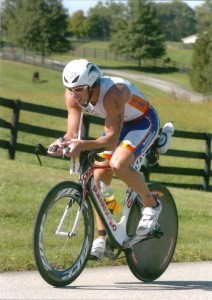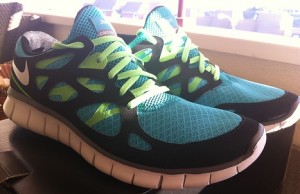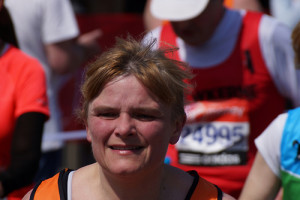by Michelle Sutton-Kerchner
Spring’s promise is all around us. Hear it in a bird’s song, smell it in fresh rain, and see it in runners sprouting up everywhere. Join the scene! Here’s what it takes to become a runner …
Competitive events used to belong to dedicated athletes. Runners were another form of jocks, sweating it out to improve endurance and strength. Some ran for the sheer pleasure; others, to help advance their primary sport. It also delivered the legendary “runner’s high.”
Today’s runner has a different profile. The diehard athlete still hits the pavement. However, joining him/her is the 40-something mom, the newly fit middle-ager, the workaholic, the dad-and-son team, and the baby boomer. The runner has evolved. People of all skill levels, age groups, and interests are recognizing the adrenaline rush of the competitive spirit. Competitive racing has grown tremendously in recent years, with 40- and 50-year olds being top participants.
The healthy-lifestyle movement, and surge of exercisers who are committing later in life, is giving birth to the realization that our past does not limit present abilities. Before you lace up and hit the road, here are some event training tips.
Determine the Specifics
Running as a hobby is a great fitness outlet in itself. If you take your run to the next level, determine the most appropriate event for you. Someone new to running should delay marathon participation until next season. Aim for a short run, perhaps a 5-mile neighborhood jaunt.
A long-term runner might be ready to tackle a marathon. A physically fit individual, new to the competitive world, may be ready to attempt a half marathon to get familiar with these events. S/he may rock on the Exercise Floor but need some adjustments when transforming to a marathon runner.
Here is the breakdown of several major competitions:
Recreational runs: Of various distances, often run for fun or as a means for fundraising.
5K: A running race of 5,000 meters or approximately 3.1 miles. Often set to raise funds for, or awareness of, a specific cause, person, organization, or charity.
10K: A running race of 10,000 meters or 6.214 miles. Less frequent than the 5K but usually created for the same type of purpose.
5-Mile & 10-Mile Runs: A race of length implied by their names. Local community races used as recreational summer events or to help a neighborhood charity.
Half-marathon: A running race of 13.1 miles. Reported as the fastest-growing race due to its challenging but abbreviated nature.
Marathon: A long-distance running race of 26.2 miles.
Triathlon: A multisport competition that consists of swimming, bicycling, and running, in that order. Occasionally, the components are split among a team of three. Distances vary among four types of triathlons: Sprint, Olympic, Half Ironman, and Full Ironman. The Sprint triathlon is recommended for beginners. It consists of .25-mile swim, 16-mile cycle, and 3.1-mile run.
There are customized training programs for racing events. Each race needs to be approached differently, depending on its requirements and your current situation. Know yourself and proceed accordingly. For example, if you’re coaching your child’s softball team, you may not have time for marathon training. Perhaps your fitness efforts have become stagnant. A marathon may be the deadline you need.
Soul Search

What is motivating you? Decide why you want this experience, and make that your ultimate goal. Common reasons people find themselves at the start line include:
- Racing for a cause/fundraising
- Honoring someone’s memory
- Celebrating a milestone birthday (fortieth birthdays are a common motivator)
- Expanding fitness efforts
- Increasing fitness results
- Satisfying curiosity (Can I do it? What does this experience entail?)
- Meeting people who share common interests or support similar endeavors
For many, it is not about mileage or time scores. Know your inspiration to create the best training plan and motivation techniques. Many existing organizations (e.g., Susan G. Komen for the Cure® breast cancer foundation) host racing/walking events to raise funds for medical research and dissemination of factual information. Events with such a mission provide a new dimension for those participating. Suddenly, running is not for your health alone. It is to help improve the health of our community at large.
That is the case for Group Fitness Instructor Don Sullivan who started a nonprofit organization. He put his passion for running to good use by founding this group, which coaches the visually impaired in sports, specifically running. Don admits he was not always a runner. “I hated running when I started. I was a swimmer and decathlete,” shares Don, who once owned fitness studios in Florida.

“I was challenged by a friend to compete in a triathlon, and came in last–despite being an athlete. But, that event inspired me. I became absolutely intrigued by running. I wanted to be around this group of supportive people who did competitive running. I wanted to discover why they did it, and become part of it.”
Don definitely developed his own love of running. It began with the first mile, which propelled him forward. Twenty-six years later, at 43 years old, he has accomplished countless competitive races. He claims to be just as fast, if not faster, than he was in his 30s. His impressive race agenda proves it, including his realistic hope of qualifying for the 2014 Ironman World Championship in Kona, Hawaii.
“Running is my escape. My Zen,” adds Don. He caught the contagious enthusiasm of this sport. “Each person strives to do his/her best, to compete, yet we are one big team.”
How-to
The Center provides everything needed to prepare for a racing event. If you’re a newbie, consider working with a personal trainer. From basic road races to marathons and triathlons, a trainer can customize a fitness plan and make suggestions based on your skill level. The support of an expert eases anxiety, provides encouragement, and increases success rate. Those who work with a trainer report improved confidence, whether striving to win first place or simply finish on their own two feet.
Experts suggest increasing miles run by 10 percent each week. You do not need to run daily. Instead, run four days weekly with a variety of other workouts in between. A general guideline provided by the American Council on Exercise suggests those who can run three to four miles continuously should train for about three months prior to a half marathon and five months before a full marathon.
Do not multitask your training plan. Alternate goals weekly. Individually focus on increasing distance, improving time, and varying terrain. To combine these challenges in one session can cause setbacks in the form of injury, exhaustion, and that defeatist attitude. Also, avoid running more than two days consecutively. Even healthy, uninjured muscles need time to repair.
Serious training for an event requires equal care shown to nutrition. Consider getting recommendations from a nutritionist for a runner’s sample diet. Be sure to include plenty of protein and adequate fiber. Along with delivering the best fuel for the body, good nutrition can enhance performance. If you consistently fall short of your program’s goals, the culprit may be on your plate. Think: sugar and caffeine versus vegetables and fiber. Load up with food that won’t load you down, and choices that build muscle rather than increase inflammation.
Allow enough time before event day to improve all aspects of your training. Speed may be your goal, but this skill works in unison with all others. Keep your program well-rounded. Build in time for rest days, sore muscles, and unenthused days (we all have them).
Stretch after your body is warm. Jog in place or do some jumping jacks first. Ice joints that bear the bulk of stress from a good run, especially knees and ankles. Apply an ice pack for about 15 minutes after running. Repeat as necessary throughout the day. Newbies should ice these joints as a preemptive measure. Although a soak in the spa pool may seem tempting post-run, go for a warm shower instead. A hot soak after running can increase any inflammation triggered during your run.
Get the Gear

Many times, we can manage without the expected equipment or attire. A tennis ball can pass in a game of catch. Accessories can dress up a casual outfit. Navy can pass for black. (Well, maybe not the latter.) When running, you cannot settle. Running shoes, socks, and clothing can make the difference between finish line and sideline.
Your cross-training sneakers cannot do this job. Shop at a running specialty store, if possible. Expect to pay decent money. Keep in mind, running is a generally inexpensive sport. Its main requirements are fresh air and open pavement. Splurge for well-fit, comfortable running gear, which includes a back-up pair of sneaks and smart-fitting undergarments. Wear running socks to protect your feet. Comfortable feet make a successful run.
Use petroleum jelly and corn starch, if chafing is an issue. Consistently apply these to problem areas, even after they clear, or risk future exacerbation. Long runs should be accompanied by adequate hydration. Invest in a lightweight water bottle with a strap or handle for these occasions. Take sip breaks every 20 minutes during endurance runs. Sports drinks replenish electrolytes while hydrating, for extensive runs and training sessions.
See It, Do It

Know what you want from the experience and go for it. Envision the finish line. Half the effort is having your mind beat your body there.
Sources
“First Marathon or Half Marathon? 8 Training Tips,” by Kathleen Doheny at www.webmd.com.
www.livestrong.com.
Image Credits
Tree fantasy: www.flickr.com/photos/ladybugsleaf/107613615/
Running shoes: www.flickr.com/photos/juanpol/5913306236/
Determined: www.flickr.com/photos/meandmyshadow/8672567497/
 Fitness & Wellness News Your Source for Fitness News, Wellness News, Health News, and Nutrition News!
Fitness & Wellness News Your Source for Fitness News, Wellness News, Health News, and Nutrition News!




